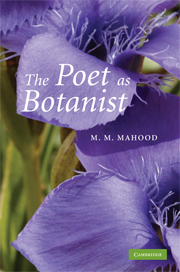Book contents
- Frontmatter
- Contents
- List of illustrations
- Acknowledgements
- A note on quotations
- Introduction
- 1 Primroses at Dove Cottage and Down House
- 2 Erasmus Darwin's feeling for the organism
- 3 Crabbe's slimy mallows and suffocated clover
- 4 John Clare: bard of the wild flowers
- 5 Ruskin's flowers of evil
- 6 D. H. Lawrence, botanist
- 7 Poetry and photosynthesis
- Index of persons
- Index of plants
4 - John Clare: bard of the wild flowers
Published online by Cambridge University Press: 22 September 2009
- Frontmatter
- Contents
- List of illustrations
- Acknowledgements
- A note on quotations
- Introduction
- 1 Primroses at Dove Cottage and Down House
- 2 Erasmus Darwin's feeling for the organism
- 3 Crabbe's slimy mallows and suffocated clover
- 4 John Clare: bard of the wild flowers
- 5 Ruskin's flowers of evil
- 6 D. H. Lawrence, botanist
- 7 Poetry and photosynthesis
- Index of persons
- Index of plants
Summary
John Keats could not see the flowers that surrounded him as he listened ‘darkling’ to his Hampstead nightingale, although from their scent he guessed them to be hawthorn, sweetbriar, sweet violets and ‘the coming musk rose’. A few miles away, in Epping Forest, but two decades later in time, John Clare was to listen to another nightingale singing, as the species mostly does, by daylight – the light of a long May evening in which the poet's eye would distinguish, below the intense green of young beech and hawthorn leaves, a ground layer of bracken, orchids and foxgloves, ‘where mugwort grows like mignonette’. Mugwort was familiar to Keats from his medical studies. But it is difficult to imagine him giving it a place in his verse; whereas the flicker of self-mockery in ‘like mignonette’ suggests that Clare knows Artemesia vulgaris to be as much at home in his poetry under its common name as sweetbriar is in Keats's ode under its pastoral name of eglantine. As honest, sturdy mugwort, it takes its due place, alongside ragwort, fleabane and sow thistle, among the 370 plants that Clare actually names in his poetry and prose.
This is an astonishing tally. Indeed the list is so comprehensive that when Clare fails to mention a common wild flower we find ourselves asking why.
- Type
- Chapter
- Information
- The Poet as Botanist , pp. 112 - 146Publisher: Cambridge University PressPrint publication year: 2008

